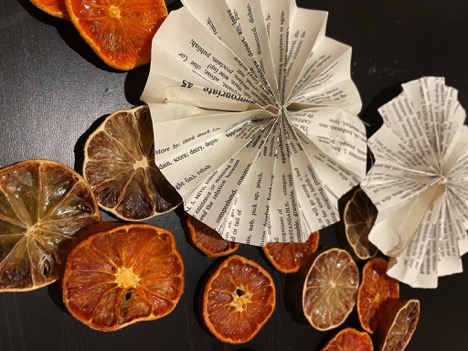Twinkling lights dotting branches of evergreen pine. Stockings draped along the fireplace. Wreaths placed carefully on top of the outer front door.
An incredibly visual season, there’s something about Christmas decorations that creates a feast for the eyes.
Growing up, my favorite holiday tradition always happened on December 1st, when we’d swap all our normal decorations for seasonal objects and bring in a fragrant pine tree into the corner of our home. There’s a magical nature to transforming a home for the season and the coziness it brings. That magic, however, comes with a price. Read on to learn more about the true cost of Christmas and how to swap your tinsel for compostable and biodegradable options instead—from in and around your home!
The Cost of Christmas
According to RocketHomes, the average U.S. consumer spent approximately $269 in 2020 on decorations, with many respondents expressing their wish to spend more to make their home festive and bright.
According to Biffa, this “Christmas pollution” leads to a 25 to 30 percent increase in excess waste from packaging, wrapping paper, cards, food, and more. The decorations you choose can contribute to overall waste, with Christmas lights increasing carbon emissions from power stations and fake snow filling your natural environment with polystyrene, a possible human carcinogen that is nearly impossible to decompose.
To avoid decoration waste, start a new tradition this year by foraging your decor. Besides being Scandinavian minimalist chic, it’s also all eco-friendly and entirely free.
Where to Forage Your Decor
In order to forage your decor, you don’t have to look much further than your own home and backyard.
For those living in colder climates, collecting pine cones, evergreen branches, and winter grasses (which look like pampas grass) is a surefire way to dive into festive decorating. You can find these in your backyard or in a nature preserve near you.
For those in warmer regions, consider bringing your climate to the season—with Christmas cactuses, local house plants in place of pine, and uniquely shaped sticks and twigs. Besides the sentimental value of bringing your location into your celebration, swapping the traditional ‘pine’ and ‘berries’ for elements from your local area will decrease shipping costs and demand for non-native decorations.
Lastly, while technically not “true” foraging, perhaps the best place to forage is right inside your pantry and fridge. Filled with naturally compostable ingredients like cinnamon sticks, popcorn, oranges, and cranberries, these zero-waste items are the perfect way to add some color to your holiday cheer. Read on below for inspiration on how to take those foraged goods and transform them into a winter wonderland.
Zero Waste Decorating Ideas
-
Decorate Your Tree with Dried Fruit

While this ‘foraging’ occurred at my local grocery store, I truly believe there’s nothing more elegant than hanging dried fruit on a tree. I utilized a mixture of oranges, clementines, limes, and lemons for variety, and sliced them thinly before baking them in the oven.
Follow this recipe to dry your own citrus fruit and finish the look with a gorgeous strand of strung cranberries or a popcorn garland.
-
Buy Gourds & Festive Squash To Ring In The Holiday Season

Creating gorgeous tablescapes for Christmas doesn’t have to involve plastic baubles, faux leaves, or overpriced runners. For a zero-waste and festive feel, opt for making a centerpiece out of colorful gourds, sourced from local farm stands and farmer markets. Layer mini white pumpkins in with natural beeswax candles and fresh sprigs of pine for an effortless and elegant look.
-
DIY An Evergreen or Berry Wreath

Skip the artificial wreath by making your own pine or berry wreath. Wreath making can soon become a special family tradition and, depending on the materials you used for the wreath (either twigs or fresher greenery) you can potentially store and reuse for years!
Follow this tutorial for steps on how to braid natural twigs and sticks for an elegant wreath to decorate your front door or wall.
-
Create A Corn Husk Angel or Paper Star Topper

While not a conventional definition of foraging, living low and zero-waste is all about making use of what you already have and I can bet that most, if not all of you, have a book or dictionary that you haven’t touched in years. Rather than donating that book or throwing it out, consider upcycling those pages into Christmas decorations instead.
One of my favorite Christmas craft is making dictionary paper stars as shown in the image above. For the extreme crafter, you can also follow instructions for making a corn husk doll to place on top of the tree in lieu of a formal angel.
***
This holiday season, do more with less. Start a new tradition of foraging your decor, and find amazement at the beautiful decorations you can make with a little effort and a lot of ingenuity.
Get more like this—Sign up for our daily inspirational newsletter for exclusive content!
__
Photo: Dana Drosdick




